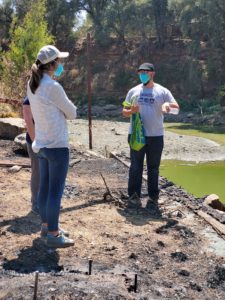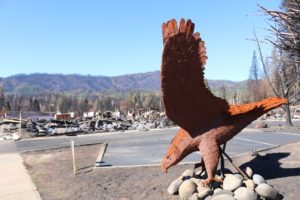Wildfire Recovery Updates from After the Fire
Each year the wildfires across the West grow larger, more severe, and there are new communities faced with recovery and rebuilding. After the Fire’s CEO Jennifer Gray Thompson and COO Charles Brooks went through these experiences with the 2017 Sonoma County Complex fires and the 2018 Camp Fire in Paradise respectively. But as the destructive power of these fires expands, the body of experience and learning from impacted communities grows, so we can adapt and recover better each time.
Even though After the Fire (ATF3R) is a small organization, it can be nimble and responsive, just in time with the right information and supportive mentoring so communities can make informed decisions and lead their own recovery. Listen to this radio show for more information.
ATF3R does not step in to lead the recovery process directly, but helps local people lead their own recovery. They accomplish this by providing a listening ear and activating dynamic connections to make progress and avoid pitfalls, all learned through prior experiences, shared and paid forward.
Brooks added, “After the Fire has evolved out of our unique collective experiences in wildfire recovery and our ongoing work to innovate the recovery process. Our team, our partners and our resources are committed to helping other communities navigate their recoveries hopefully shortening the recovery time, all at no cost to the community.”

After the Fire's team surveys the Cache Creek fire's proximity to the watershed with Lake County Supervisor Bruno Sabatier
This kind of help made a difference in Lake County recently after the Cache Creek fire destroyed mobile home parks. The scale of this fire was smaller than other megafires, however the areas that were destroyed were located next to an important watershed. If the toxic runoff from the fire zone was not cleared soon, a secondary disaster of contaminated water would result. So ATF3R met with Lake County leaders to draft an urgent message to the state leaders and helped advocate for rapid debris removal, amplifying the message. What happened next? Governor Gavin Newsom declared a state of emergency for the Cache Creek area, and debris removal is planned for mid-October, ahead of rainy season. And according to city manager Alan Flora, the CA Department of Water Resources, the State Water Board and the California Conservation Corps have installed emergency BMPs — shorthand for best management practices — equipment to safeguard the waterway.
In Santa Cruz, the 2020 CZU Lightning Complex Fires not only destroyed homes, but severely damaged a local salmon hatchery, including the site’s access bridge. After the Fire visited the site, met with the hatchery team, and then reached out to share the story of the damage and detail what help was needed to restore operations. The ATF team was able to get the San Francisco Chronicle to cover the story which led to new financial donations and a significant grant to help restore the facility and rebuild the bridge. And this year, ATF3R is collaborating with Santa Cruz community leaders to find alternative solutions to costly plumbing infrastructure for home rebuilders whose land is located near fragile watersheds or is set on difficult mountain terrain.
In 2020, communities in Oregon faced their most destructive fires in state history. The September Almeda Fire tore through Ashland, Talent, Phoenix, and Medford destroying more than 2,300 residential structures, of which three-fourths were mobile homes and low-income housing. After the Fire’s team provided support and guidance as the local community organized the recovery, guiding grassroots leaders through the steps toward recovery, and seeking innovative solutions to helping those most in need a way to get back home. In collaboration with Fannie Mae, ATF3R worked to provide a funding model to make the mobile home recovery more accessible and achievable. Read more here.

View of downtown Greenville, CA after the Dixie Fire destroyed all the buildings.
And now ATF3R is monitoring reports and connecting with local leaders regarding this season’s wildfires. The Dixie fire started on July 13, 2021 and is still burning, scarring land across five counties and destroying nearly 1 million acres, including the historic gold rush town of Greenville, CA. ATF3R is actively reaching out, helping guide local officials, business owners and community groups and sharing strategies for the first steps to a solid recovery.
The team has already visited Greenville twice and pledges to be a resource at each stage, offering help when requested. (Read more here.) Wildfire recovery takes years to accomplish. Just in the last several weeks the team has been up to Lake County, back to Santa Cruz, and to the Woolsey Fire area in LA and Ventura County, checking in, listening closely, and offering guidance.
Over the next couple of months, ATF3R plans to make trips to meet with groups in Santiam Canyon, OR and Grizzly Flats, CA too. And with each fire impacted community they assist, a network of wildfire survivor community leaders grows. ATF3R aims to help these emergent leaders stay connected as they work through the many lengthy stages and challenges of rebuilding and resilience.
CEO Thompson noted,” We do not lead the recoveries, we lead the mission to connect wildfire survivors, innovate for resiliency and recovery, and provide a national voice for policy reforms specific to wildfires. We support LOCAL leaders via mentoring, systems, tools, and peer to peer support all are adaptable to the specific needs of each recovery. “ Read more here.
